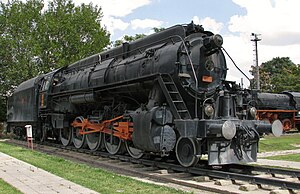56301 class Type and origin Power type Steam Builder Vulcan Iron Works Serial number 4790-4877 Build date 1947-1949 Total produced 88
Specifications Configuration: • Whyte 2-10-0 • UIC 1′E h2 Gauge 1,435 mm (4 ft 8+ 1 ⁄ 2 in ) Driver dia. 1450 mm Wheelbase : • Coupled6808 mm Loco weight 101,9 Tender weight 32,7 Fuel type coal Fuel capacity 12,7 ton Water cap. 30,2 m3 Boiler pressure 17,6 bar Cylinder size mm × 711 mm (23+ 5 ⁄ 8 in × 28 in)
Performance figures Maximum speed 70 km/h Power output 2350 hp
Career Numbers 56301 - 56388 Nicknames Skyliners Preserved 4, with remains of 2 more for parts
The Turkish State Railways (TCDD) 56301 Class is a class of 2-10-0 steam locomotives known as "Skyliners". They were built by Vulcan Iron Works of Wilkes-Barre , Pennsylvania . The 88 locomotives in this class were numbered 56301-88. The first arrived in 1947.
They were the first American -built locomotives ordered by TCDD, though they had acquired ex-USATC S200 Class (TCDD 46201 Class ) and ex-USATC S160 Class (TCDD 45171 Class ). This class had the largest boiler and firebox of any Turkish locomotive and were the only ones fitted with mechanical stokers .
At least 4 are known to be preserved, these being 56375 at the TCDD Open Air Steam Locomotive Museum in Ankara , 56337 at the Çamlık Railway Museum , 56378 at Tren Park within Karabük University , [ 1] and 56359 stored serviceable at Çankırı. The remains of 56369 and 56376 are also at Çankırı, serving as parts sources for 56359. [ 2]
This page is based on this
Wikipedia article Text is available under the
CC BY-SA 4.0 license; additional terms may apply.
Images, videos and audio are available under their respective licenses.
